ABSTRACT
The caterpillar fungus, Yartsa Gunbu (Ophiocordyceps sinensis (Berk.) G.H. Sung et al.), offers one prime example of the phenomenon, where a resource of immense economic value runs the risk of being over-exploited, more so when its exploitation remains a ‘common property resource’. The ever-increasing demand of the commodity in the international markets and concomitantly its ever-increasing price, hovering at present at US$ 20,000 per kilogram locally, has resulted in not just its rampant exploitation but also the degradation of the very habitat, thus endangering its sustainability. The present study conducted across 9 broad study sites, across 110 villages and 2511 harvesters, within the Pithoragarh district, Central Himalaya delves into the following broad objectives; (i) quantity of the harvested lot from the region; (ii) effect of over-harvesting vis-a-vis the degradation of the prime habitat on the quantity harvested each year, as also (iii) its effect on the population size of the host larva (Thitarodes), and lastly, (iv) comparative study of the income generated out of the sale of Yartsa Gunbu, with the traditional sources of income. Field visits were made to each of the village; information was gathered through open-ended questionnaire. Host population size study was conducted in three selective sites through hand-sorting method. While over-all quantity of the harvested lot has shown an increase; habitat-wise the quality harvested has shown a perceptible decline in three broad study sites, a trend likely to be replicated by rest of the sites, which currently though is experiencing an increased yield.
Key words: Economy, ethnobotany, habitat ecology, Ophiocordyceps sinensis, sustainability, Yartsa Gunbu.
The mushroom is also called the ‘caterpillar fungus’ on account of its origin, and, more frequently Yartsa Gunbu, which translates as ‘winter worm, summer grass’, or locally in Kumaun and Garhwal Himalaya as ‘Keera ghas’, referring to the Larva (syn. keera) and the emergent fruiting body that appears as sprouting grass (syn. ghaas). Ophiocordyceps is a genus of mostly entomophagous flask fungi (Pyrenomycetes, Ascomycotina) belonging to family Ophiocordycipitaceae. The British mycologist Berkeley (1843) first described it in 1843 as Sphaeria sinensis Berk. Later Saccardo (1878) renamed it as Cordyceps sinensis. Based on molecular phylogenetic study, Sung et al. (2007) separated the mega genus Cordyceps into four genera, viz. Cordyceps (40 spp.), Ophiocordyceps (146 spp.), Metacordyceps (6 spp.) and Elaphocordyceps (21 spp.), while the remaining 175 spp. were left in the Cordyceps group. As a result, C. sinensis was transferred to Ophiocordyceps, hence renamed as O. sinensis.
Ophiocordyceps sinensis parasitizes various grass root boring Thitarodes (previously Hepialus) caterpillars, which hatch as ‘ghost moths’ when not preempted by Ophiocordyceps. The infective cycle begins with the germination of the fungal spore on the thin integument of the host larva, presumably, during the period of molting, when the larva is most sensitive. The hyphae of the mycelium develop inside the body of the insect, first feeding on less vital parts before taking over the complete organism. Eventually the insect is completely mummified and emptied of nutrients, and all that remains is the exoskeleton filled and coated with Ophiocordyceps mycelium. In spring, the mushroom (the fruiting body) develops out of the head of the exoskeleton just above the eyes. The slender, brown, club-shaped fruiting body then emerges from the ground, reaching a total length of 8 to 15 cm (Figure 1). The fruiting season starts as early as mid-May on the eastern slopes of the Kumaun Himalaya, and consequently the harvesting season lasts locally about six weeks. However, the fruiting is delayed locally with increasing altitude, thus the fungus can be collected for nearly two months at different altitudes in some areas. By mid-June to mid-July the collection season is over, but mature fruit bodies with low value are reported to persist into August.
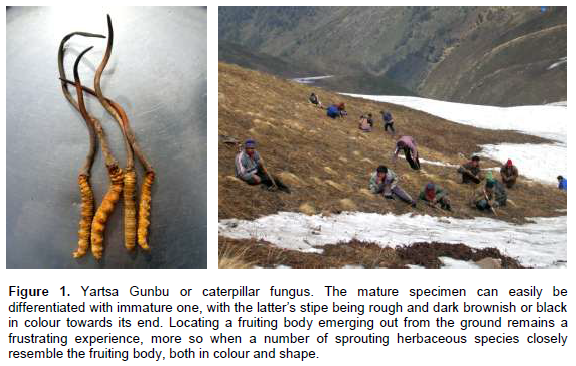
Ethnobotanical use
Traditionally, it has been found that most local folk/traditional healers use Yartsa Gunbu to treat 21 ailments, including erectile dysfunction, female aphrodisiac, malignant tumours, bronchial asthma, bronchitis, diabetes, cough and cold, jaundice, alcoholic hepatitis, among others. The traditional uses of Yartsa Gunbu among the Bai, Naxi, Lisu and Tibetan people living in the mountainous Northern Yunnan province include improving eyesight, in the treatment of calcium deficiency (specific to children), diabetes and associated nephropathy, and indigestion (specific to children), to speed up the labor or parturition, and to strengthen the immune system (Chen et al., 2010).
In some parts of Nepal, Yartsa Gunbu is powdered and combined with the rhizome of Dactylorhiza hatagirea for consumption (Adhikari, 2000); which along with honey and cow’s milk is used as tonic and aphrodisiac (Lama et al., 2001; Prasad and Satyaal, 2006). As a tonic and for the purpose of sexual stimulant, people of both sexes normally use a daily combined dose of one dried Yartsa Gunbu with half liter of milk and two teaspoons of ghee (clarified butter) for a week. Invariably, young or immature Yartsa Gunbu- golden-coloured larvae with short or insignificant fruiting body are recommended for the preparation of the sexual-stimulant (Prasad and Satyaal, 2006). As relates to the present area of study, it has been reported that in Dharchula, the locals consume Ophiocordyceps along with local brew, Chakti. The mode of intake is that Ophiocordyceps is left in the local drink for a period lasting for few days, and then consumed (Garbyal et al., 2004).
Over the last two decades, invariably on account of the two pulling forces- ever-increasing demand of the commodity in the international markets and concomitantly its ever-increasing price, hovering astoundingly at present at US$ 20,000 kg-1 (1 US $= 60 rupees), has resulted in not just its rampant exploitation but also the degradation of the very habitat, thus endangering the future viability of the prized species. In the absence of real time data pertaining to the following; (i) over-all volume or the harvested lot from the district (that again is traded illegally across the border), (ii) environmental cost of the harvesting pressure; (a) on yield of Yartsa Gunbu, (b) on the population of the host insect (Thitarodes), and (iii) perceptible socio-economic changes in the lives of the harvesters, the present paper attempts to address the above-mentioned objectives with an aim to evolve sound management practices to safeguard the resource for future.
Study area
The study was conducted in district Pithoragarh, Kumaun Himalaya.
The study sites extend between 3200 to 4000 m above mean sea level and lie between 80°15′ to 81°5′ E longitude and 29°5′ to 30°32′ N latitude. Areas known for the availability of the Yartsa Gunbu, encompassing the villages involved in the harvesting, have been divided into 9 broad study sites (Figure 2). The three study sites- Naginidhura, Janthari and Marjhali, selected for intensive study of host insect population size, exhibit considerable variations in precipitation pattern, with the average rainfall ranging between 150 and 200 mm per annum, with the observed mean temperature between 10°C in shade and 15°C in open area, during the conduction of the study (mid-June- July-end).
Data collection
The study was conducted from 2012 to 2014, across the district in 110 villages, known for harvesting Yartsa Gunbu. The landscape was divided into 9 major study sites to make a comparative assessment of the salient aspects, primarily of quantity harvested over the last 5 year period, anthropogenic pressure, management practices (if any). Primary data was collected from a total of 2511 informants, across different age groups, even though efforts were made to elicit information from the family head. Qualitative data ,
viz., (i) collected lot per season over the last 5 year period, (ii) income earned, (iii) price of the commodity over the last 5 years, (iv) criteria for quality assessment of the sample harvested, and else, (v) the dilution of the traditional conservation practices and of the taboo systems, (vi) a comparative study of the income earned out of the sale of the produce (Yartsa Gunbu) versus the traditional means of livelihood, viz., (a) income from agriculture, (b) medicinal and aromatic plants (MAPs) exploited from the wild and (c) the livestock population and the products derived from it. The information was elicited through an open-ended questionnaire. For population assessments of the host insect (Thitarodes), 1 x 1 x 1 feet pits were dug, 5 each within a quadrate of 5 X 5 meters, numbering a minimum of 10 in each study site, taking cognizance of the slope aspects (3), extending from 3200 to 4200 m amsl; the number of individuals of larva was assessed by hand sorting method.
Habitat ecology
Within the broad landscape of district Pithoragarh, Kumaun Himalaya, the most heavily exploited sites are the following: Chiplakot and adjoining Sumdum; Philam, Bon, Baling, Dugtu and Daantu in Darma Valley; Marjhali and Ralam Dhura in Ralam river watershed; Panchachuli (Balati glacier) in the River Mandakini watershed; Nagnidhura and the adjacent Jhanthari meadows lying above Gauri paar watershed; and finally Chhiyalekh and adjoining range in Vyas valley (Negi et al., 2006, 2014, 2015).
Within the study areas, it was observed that north-facing and gentle slopes, preferably little away from water body, but laden with above ground preferred herbaceous families including primarily Polygonaceae, Fabaceae, Cyperaceae, Poaceae and Liliaceae, harbour good population of host species (Thitarodes), and thus of Yartsa Gunbu. This fact was also substantiated by the harvesters, who, built on their experience, would frequent these spots, least oblivious of what constitutes north or south-slopes. The soil is sandy-loam, with pH always slightly acidic, usually around 5, in all the sites.
Even though the distribution of the O. sinensis in the landscape is confined within 3200 and 4800 m, a relatively wide niche one would believe, however since the topography within the alpine zone, show extreme variability in terms of the micro-habitats, the niche breadth eventually narrows down. Another bare fact to take note of is that lately, the lower reaches of the habitats, previously being harvested for Yartsa Gunbu, no longer harbour the same. This could be ascribed on account of the space being occupied by the harvesters during their interim stay during the harvesting season. Since the quantity harvested is inversely related with the gradient of slope, that is, with greater availability reported at 15° slope, and progressively declining with greater angle; the very ‘act of stay’ negatively impacts upon the yield of Yartsa Gunbu (Figure 3).
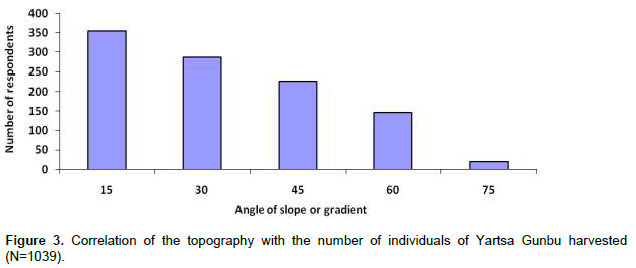
Habitat destruction brought about by the ever increasing harvesters remains the major cause of concern. This fact becomes obvious since the harvesters themselves have to procure the fuel wood from relatively greater distance (200 to 300 m) downhill in a number of sites visited. Lately however, the elderly folks have begun raising their concern as relates to the fast depletion of the woody species; more so when the local harvesters are out-numbered by the contract labourers from outside, who for obvious reasons, have least regard for the sacred landscape or its flora. Five years back, the present author had successfully implemented an effective mechanism to restrict the outsiders- not belonging to the said Van panchayat (forest council) by issuing permits to the local inhabitants of the village only. It was unfortunate to come across the fact that these passes (distributed even to infirm and elderly) are now auctioned to outsiders at unbelievable price (up to US$ 1,166 per pass). Yet another latest feature of exploitation (even though disliked by many) is hiring of labourers (mostly the proficient Nepalese) on contract basis by the local powerful villager, whose sole job is to make provisions for their lodging in the alpine meadows, in return for 50% of their harvested lot. Interview with the Nepali labourers was: ‘the population size in their meadows has declined (precipitously, and in fact, parting with 50%of their produce fetches more money that what they would earn
in Nepal)’. The situation is greater number of harvesters, arriving too early in the habitat sites; competing among themselves to harvest his/her larger share, only lends credence to Hardin’s ‘Tragedy of the commons’ (Hardin, 1968). The aftermath is a desolated landscape, bereft of the erstwhile woody species, and concomitant loss of the refuge of such wild species, such as Monal pheasant (Lophophorus impejanus) and muskdeer (Moschus chrysogaster chrysogaster).
Abundance of the host larva
The overall availability of the O. sinensis has to be seen vis-à-vis the population dynamics of the host insect, whose population again would be determined by the precise health as well as number of the host plant species. Reportedly, the normal reproductive cycle for Thitarodes (Hepialus) takes up to five years; most of the life cycle is lived as a caterpillar, the moth itself living for only a short time, 2 to 5 days in the case of H. biruensis (Chen et al., 2002). The host for C. sinensis most commonly reported is Thitarodes armoricanus (Oberthür) Ueda, Hepialidae, Lepidoptera. Other host larvae have been identified, such as Hepialus oblifurcus Chu & Wang (Gao et al., 1992), H. baimaensis Liang and H. biruensis Fu Huang & Chen (Chen et al., 2002). All in all, nearly 50 species of Thitarodes (Hepialus) moths are recognized, out of which 30 species are known to be infected by Ophiocordyceps sinensis (Chen et al., 2002). The genus Thitarodes was erected in 1968 to accommodate H. armoricanus and other related species placed originally in Hepialus, many of which are the host for O. sinensis (Nielsen et al., 2000).
During the study, the larval stages of the moth were encountered even at the depth of 2 feet or more, even though for the population study, the study was confined to 1 feet depth only. Early stage larva reportedly are confined to greater depth than those of, say the fourth or fifth instar larva, which normally is the developing stage of the host larva, usually encountered by the harvesters, hidden or just emerging out from the superficial upper layer of soil, that are infected by the spores of the O. sinensis, probably just before it undergoes molting (4th instar larva) or pupation (5th instar larva), since these stages are the only ones encountered, above ground. However, from the conservation point of view what is more important is the fact that a significant, 14.81% decline in the population of the host insect has occurred within just two years (Table 1). Even though, the perceptible decline cannot be taken as conclusive, the present preliminary study does re-enforce the belief that greater anthropogenic pressure invariably has negative effect upon the host larval population. However, conclusive results can only be drawn if (i) similar studies are conducted across multiple sites differing in intensity of harvest, (ii) undertaken over a relative longer time span, and (iii) environmental variables affecting the population size of the host larva are recorded.

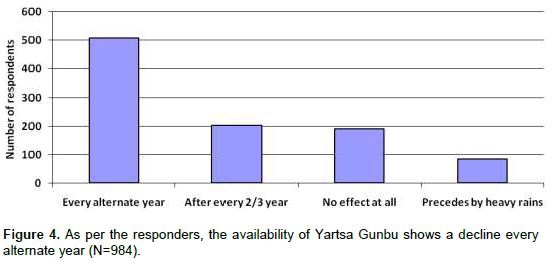
Quality of specimen traded and ecological implications
Ophiocordyceps is traded in several categories; the main criteria defining the quality of the produce, in order of preference are the following: Lower water content (completely dried samples are preferred than the fresh ones), the state of processing (cleaned rather than uncleaned), and the size. Freshly harvested caterpillar encased in black topsoil layer is usually cleaned with a toothbrush and then dried under shade. The degree of dryness of Yartsa Gunbu is an important factor that controls weight, a price determining factor. Dealers assess the moisture content by the flexibility of the fungus; the less pliable the fungus, the dryer it is. Prices clearly fluctuate through the year, especially depending on the annual harvest.
Another very important quality besides larval size is the ratio of the size of the fruiting body, growing out of the head of the larva, versus the size of the insect larva.
Highest value is for a Yartsa Gunbu, whose fruiting body is bit shorter than the larva or at least not much longer, since in general this ratio indicates the timing of the harvesting (Figure 5). The healing power of Yartsa Gunbu is in fact believed to be concentrated in the caterpillar, filled with Ophiocordyceps mycelium. Firmness of the larva is thus important in pricing. The harvesters are thus forced to collect caterpillar fungus early in the season. In fact, 70 to 80% of the harvested lot consists of immature specimens. This figure could be on higher side, but relates well with the finding of Shrestha and Bawa (2013), who reported 94.4% of the caterpillar fungi as reproductively immature from Dolpa district, Nepal.
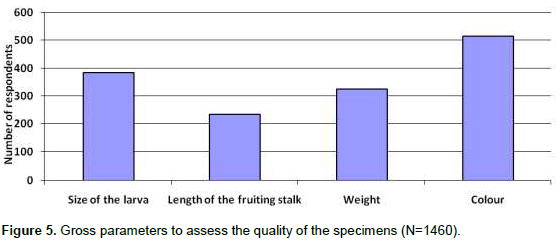
Needless to emphasize, collection of such specimens will negatively impact reproduction and its future availability in the wild. The exorbitant price hike only makes the practice more detrimental. Educating the harvesters about the precise life cycle and the importance of the availability of the mature specimens for the completion of the infective cycle would go a long way in sustaining the future availability of the Yartsa Gunbu, or a mechanism is evolved whereby the duration of the harvesting is reduced, allowing a proportionately greater number of individuals to mature and disperse their spores. With perceptible decline in yield per unit space, and as observed by the harvesters, this remains the only alternative to safeguard or assure the availability of the resource for future.
Economics of Yartsa Gunbu
Anyone familiar with fungi is aware of the enormous fluctuations in yearly production of fruiting bodies, generally perceived as the result of fluctuations in weather conditions, which impacts on the life cycle of the host insect. Additionally, incongruities in data collected at the household level can appear, when collectors do not want to disclose how much they are actually collecting, more so, when the product is very valuable; also ambiguity remains as to its legality of exploitation. The results of the survey work show that while the quantity harvested collectively over the broader landscape has remained more or less steady over the last 5 years, the price of the commodity has increased many folds (Figure 6). In fact, the highest price offered during the penultimate year becomes the base-price for the next year. In other words, the price per kg of US$ 20,000 in the year 2012 becomes the base price for the year 2013. While the price of the commodity has only increased sharply, the quantity harvested is pattering off.
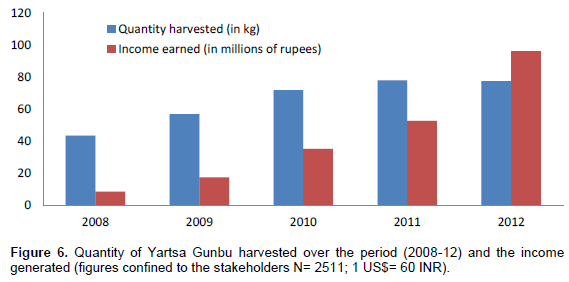
Figure 7 brings out explicitly the decline in quantity harvested of Yartsa Gunbu in Johaar, Darma and Gori
Paar valleys. One might ask what the reason is. These three landscapes are representative of habitat sites, which have been extensively explored for the presence of Yartsa Gunbu in the beginning, discovery of new sites only led to increase in the harvest. However, with no new sites left to be explored, concomitant to increased anthropogenic pressure, the yield eventually declined. The declining yields exhibited by these three valleys offer lesson that the future viability of the produce is intimately bound with the harvest pressure and the resultant denudation of the vegetation cover of the habitat sites.
Apart from Johaar (and to some extent the Darma) valley, the income earned from Yartsa Gunbu forms the only means of sustenance, presently (Figure 8). The problem is accentuated by the fact that most, if not all, have lately started showing indifference towards growing their traditional crops, or at the best leaving the same to the mercy of the wild animals, especially the monkey. While the yield has remained more or less stagnant over the last three years (2010-2012), the income earned has more than doubled over the same period! In fact, the income generated by the Yartsa Gunbu, restricted to a bare one and half months period far exceeds the traditional sources of income combined (Figure 8). This is a cause of concern, more so in the absence of any pro-active measures to manage the exploitation of Yartsa Gunbu, and the resultant (and very much conspicuous) deterioration of the habitats; the future availability of Yartsa Gunbu remains doubtful. What is warranted is to find ways whereby the pressure on Yartsa Gunbu is minimized.

The multiple effects of the Yartsa Gunbu harvest
When the price of the commodity hovers above US$ 20,000 kg-1 locally, it would seem that the harvesters are making a fortune. However, the truth remains that the yield per family averages between 150 and 300 specimens only. Considering the fact that around 3600 to 4200 Yartsa Gunbu pieces make up a kilogram; the family usually ends up earning between 1 and 2 lacs only. Considering the fact that the traditional means of sustenance- agriculture, livestock, and collection of medicinal herbs, is barely substantial, the extra income earned through sale of Yartsa Gunbu has just about enabled the poor to make secure investments, such as reconstruction of houses, education of children, else (Figure 9).
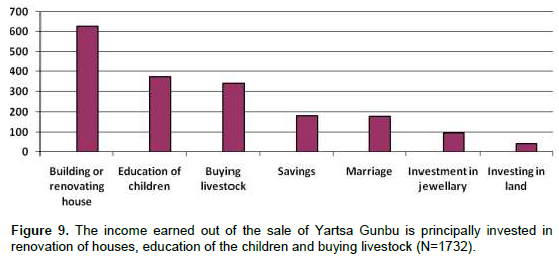
Yet another fortunate outcome of the Yartsa Gunbu phenomenon is that the bhotiya tribesmen, who had long lost touch with their villages, principally their summer homes, are now returning back to their roots. In fact, claimants are busy tracing their roots to a village with Van Panchayat harbouring Yartsa Gunbu. One could thus envision that the resultant longer duration of stay in summer homes will in turn encourage the villagers to go-in for cultivating the crop species, such as Nappal (durum wheat), erstwhile main crop of commerce traded with the Tibet. In zist, any effort on part of the policy makers or the enforcement agencies bent on prohibiting the exploitation of the Yartsa Gunbu, need to appreciate the above-mentioned facts; and thus endeavour not to bar the locals from harvesting of Yartsa Gunbu per se, but more importantly make them aware of the declining yields of the produce, and how best they can stop the trend.
Dilution of traditional conservation practices
i. The fact remains that until a few years back, the womenfolk were tabooed to enter into the alpine meadows (considered sacred), which obviously restricted the number of the harvesters. However, with the increase in the price of the commodity, the age-old taboo is now grossly discarded, and the womenfolk are actually encouraged to go for collection.
ii. Harvesting of the medicinal and aromatic plants (MAPs), such as Kutki (Picrorhiza kurrooa), Salampanja (Dactylorhiza hatagirea), Jatamasi (Nardostachys
jatamansi), Ginjari (Chaerophyllum villosum), etc would only begin towards late-half of September, post the flowering and shedding of the seeds. However, presently exploitation of these species is carried out along-side Yartsa Gunbu.
Given the ever increasing demand in the international markets and the price of the commodity, it would be safe to presume that Yartsa Gunbu faces a very bleak future, not just because of harvesting alone, but more on account of the degradation of the very habitat and denuding vegetation cover, upon which its host thrives. Obviously, efforts of the policy makers as well as of enforcement agencies, both at the state level as well as village-level institutions have failed to stop the trend. The precarious situation is accentuated by the fact that the local inhabitants across the broad landscape in general, lack opportunities to raise their socio-economic profile via-a-vis other traditional means of livelihood.
Even though, a small segment of the locals have begun raising their voice, primarily as relates to the degradation of the habitats sites, more so since the same constitutes sacred sites, too; this is less likely to have any impact. Since the degradation is wreaked more by the outsiders, the contract labourers, issues are being aired in the village-level meetings against such practices. It is vital that local-specific awareness campaigns be launched to educate the stakeholders of the declining population size of not just the Yartsa Gunbu per se, but also of its host insect; and the close relationship between the availability of the Yartsa Gunbu with the population size of the host larva; or to extend it further, of the association between the host larva and the intactness of the above-ground vegetation.
The amount as well as frequency of harvests can be altered by evolving policies or through implementation of regulatory mechanisms (Olsen, 2005; Weckerle et al., 2010), or at times even through alternative economic incentives for not harvesting (Varghese and Ticktin, 2008). However, when the targeted species fetches more than US$ 20,000 kg-1 locally, the provision of incentive becomes impracticable. However, regulatory mechanism could bear fruit, if the villagers are convinced about the negative impact of their harvesting on the sustainability of the resource. Any other regulatory means would simply prove inadequate, on account of (i) lack of manpower to monitor the harvest, confounded by near inaccessibility of the mountain terrain, even though explored by the harvesters, and (ii) the sear financial gains accrued to the harvesters out of the exploitation of Yartsa Gunbu.
There is an urgent need to educate the villagers on (i) the need to restrict the numbers of the harvesters, say, restricting the number of members per household, (ii) shortening the length of their stay in the alpine meadows, to be enforced by a management body, which will check if any infringement to the established norms is flaunted. It is strongly believed that the local collectors can be the best stewards of their resources, if they are well informed and understand what is at stake. Under such circumstances they could accept certain regulations-crucially the stopping of collection once sporulation begins late in the season- as part of sustainable resource management, (iii) ensuring that degradation of the habitats, primarily on account of procuring the fuel wood, and thus species, do not take place, (iv) an effective mechanism be evolved at the village level to ascertain the quantity of the harvested lot vis-à-vis the extent and duration of the harvesting, and finally (v), a legal status to the harvesting of the species be rendered forth, so that the produce gets marketed and not trafficked across the borders.
Empowerment remains the key word. The village level institutions needs to be involved in the formulation and implementation of any policies that relates to conservation or development. Instead of multiplicity of institutions, already existing village level institution should be merged (for example Ecodevelopment Committee would infact be part and parcel), and with whom management concerns could be shared for implementation. As relates to Yartsa Gunbu, record of collections should be maintained by the village Van Panchayat (forest council). Also efforts should be made by the government to auction the produce to the international buyers directly, to get rid of the middlemen, and the loss to the exchequer. This will not just result in the transparency of the trade, but most importantly will garner maximum financial benefit to the harvester as well as generate revenue to not just the village council but also to the state, at large. More so, when the price of Yartsa Gunbu at the local level, US$ 20,000 per kg seems incredible, the price of the best quality Yartsa Gunbu fetches US$ 1,00,000 kg-1 in China, and US$ 1,30,000 kg-1 in Singapore (Shrestha and Bawa 2013).
Because local harvests are often guided by demand and price in regional and global markets (Weckerle et al., 2010), rising prices results not just in over-exploitation of the species (Nijman, 2010), but very often, the collected lot remains unsold in the vain belief that a far better price would be earned, if the sale is kept in abeyance. This phenomenon, very often leads to deterioration and thus quality of the harvest, and concomitantly its market value. In addition, the mystery that shrouds the very legality of the harvest, only accentuates the problem further. Hence the need for a transparent policy that governs the harvest, its recorded quantity, and its sale could only lead to extension of technology, in terms of better storage or processing, can be extended to the villagers.
The authors have not declared any conflict of interests.
The author gratefully acknowledges the financial help received from the Ministry of Environment, Forests and Climate Change (Government of India), Paryavaran Bhawan, CGO Complex, New Delhi. The study however, would not have been possible without the help of the village residents-the ultimate custodians of the biodiversity.
REFERENCES
|
Adhikari MK (2000). Mushrooms of Nepal. P.U. Printers, Kathmandu, Nepal.
|
|
|
|
Berkeley MJ (1843). On some entomogenous Sphaeriae. Lond. J. Bot. 2:205-211.
|
|
|
|
Chen J, Lee S, Cao Y, Peng Y, Winkler D, Yang D (2010). Ethnomycological use of medicinal Chinese caterpillar fungus, Ophiocordyceps sinensis (Berk.) G.H. Sung et al. (Ascomycetes) in Northern Yunnan province, SW China. Int. J. Med. Mushrooms 12(4):427-434.
|
|
|
|
Chen SJ, Yin DH, Zhong GY, Huang TF (2002). Study on the biology of adult parasite of Cordyceps sinensis, Hepialus biruensis. China J. Chin. Mat. Med. 27(12):893-895.
|
|
|
|
Gao ZX, Chen J, Yu H (1992). Study on the main host swift moth, Hepialus oblifurcus Chu et Wang of caterpillar fungus, Cordyceps sinensis (Berkeley) Sacc. in Kangding. Acta Entomol. Sin. 35(3):317-321.
|
|
|
|
Garbyal SS, Agarwal KK, Babu CR (2004). Impact of Cordyceps sinensis in the rural economy of interior villages of Dharchula sub-division of Kumaun Himalayas and its implications in the society. Ind. J. Tradit. Knowl. 3(2):182-186.
|
|
|
|
Hardin G (1968). The Tragedy of Commons. Sci. 162:1243-1248.
Crossref
|
|
|
|
Lama YC, Ghimirey SK, Thomas YA (2001). Medicinal Plants of Dolpa: Amchis' Knowledge and conservation. WWF Nepal Program, Kathmandu. P 56.
|
|
|
|
Negi CS, Joshi P, Bohra S (2015). Rapid Vulnerability Assessment of Yartsa Gunbu (Ophiocordyceps sinensis [Berk.] GH Sung et al.) in Pithoragarh District, Uttarakhand State, India. Mt. Res. Dev. 35(4):382-391.
Crossref
|
|
|
|
Negi CS, Koranga PR, Ghinga HS (2006). Yar tsa Gumba (Cordyceps sinensis): A call for its sustainable exploitation. Int. J. Sustain. Dev. World Ecol. 13(6):165-172.
Crossref
|
|
|
|
Negi CS, Pant M, Joshi P, Bohra S (2014). Yar tsa Gunbu [Ophiocordyceps sinensis (Berk.) G.H. Sung et al.]: the issue of its sustainability. Curr. Sci. 107(5):882-887.
|
|
|
|
Nielsen ES, Robinson GS, Wagner DL (2000). Ghost-moths of the world: a global inventory and bibliography of the Exoporia (Mnesarchaeoidea and Hepialoidea) (Lepidoptera). J. Nat. Hist. 34(6):823-878.
Crossref
|
|
|
|
Nijman V (2010). An overview of international wildlife trade from Southeast Asia. Biodivers. Conserv. 19:1101-1114.
Crossref
|
|
|
|
Olsen CS (2005). Trade and conservation of Himalayan medicinal plants: Nardostachys grandiflora DC. and Neopicrorhiza scrophulariiflora (Pennell) Hong. Biodivers. Conserv. 125:505-514.
Crossref
|
|
|
|
Prasad KC, Satyaal J (2006). Drabya-Guna-Bigyan, Upacharma Upayogi Banaspatic Aausadhiharu. Makalu Books and Stationers, Kathmandu, In Nepali. P 150.
|
|
|
|
Saccardo PA (1878). Enumeratio pyrenomycetum hypocreaceorum hucusque congitorum systemate carpologico dispositorum. Michelia 1(3):277-325.
|
|
|
|
Shrestha UB, Bawa KS (2013). Trade, harvest, and conservation of caterpillar fungus (Ophiocordyceps sinensis) in the Himalayas. Biol. Conserv. 159:514-520.
Crossref
|
|
|
|
Sung GH, Hywel-Jones NL, Sung JM, Luangsa-ard JJ, Shrestha B, Spatafora JW (2007). Phylogenetic classification of Cordyceps and the clavicipitaceous fungi. Stud. Mycol. 57:5-59.
Crossref
|
|
|
|
Varghese A, Ticktin T (2008). Regional variation in non-timber forest product harvest strategies, trade, and ecological impacts: the case of black dammar (Canarium strictum Roxb.) Use and Conservation in the Nilgiri Biosphere Reserve, India. Ecol. Society 13(2):11.
|
|
|
|
Weckerle CS, Yongping Y, Huber FK, Li Q (2010). People, money, and protected areas: the collection of the caterpillar mushroom Ophiocordyceps sinensis in the Baima Xueshan Nature Reserve, Southwest China. Biodivers. Conserv. 19:2685-2698.
Crossref
|